 Your new post is loading...
 Your new post is loading...
In their book Made to Stick: Why Some Ideas Survive and Others Die, authors Chip and Dan Heath argue that stories are powerful persuaders because of their ability to simulate and inspire. When writing that book, they read hundreds of stories to search for templates of stories that would motivate, energize, and drive productive action. The Heath brothers identified three basic story templates: the challenge plot, the connection plot, and the creativity plot. Those plots are based on Chip Heath's research at Stanford University. I've added a fourth, called the cautionary plot. Each of these four approaches can, depending on the specific circumstances, convince the buyer to accept change—i.e., be come amenable to buying the seller's product or service....
Let’s not kid ourselves. Telling a compelling story about your business or brand on social media is exceptionally difficult. Social media posts—with their character restrictions and limited screen real estate—are not ideal for expressing brand promises, values, and philosophies with any real detail or emotional impact. This is why many marketers supplement their social media strategies with a content marketing strategy as a means of including long-form content. Thankfully, the major social media platforms recognize that this issue exists, and have taken strides to incorporate content formats that are optimal for telling better brand stories. This article will discuss three such content types...
Today, if you’re not telling a story that captivates your audience, you simply won’t be heard. Video storytelling is most effective when the story being told is relevant to the brand, entices viewers to change their behavior, and motivates them to buy a product or service. Hitting this trifecta is no easy task, but with the right strategy, video can ultimately become your most powerful marketing medium. Who ever thought a soap company could create a campaign that revolutionized the way women — and, really, the entire world — defined “beauty”? When done right, one short digital clip can go viral and motivate viewers across the globe to change their outlooks and behavior. Let Your Story Do the TalkingEvery brand story must include three key ingredients:...
Researchers Rob Walker and Joshua Glenn created SignificantObjects.com as a way to show the value of storytelling. They acquired several random inexpensive knick-knacks from eBay actions — averaging $1.50 per purchase. They had writers create heartfelt stories about these tchotchkes: items such as a butter dish, a porcelain miniature and a mini jar of mayonnaise. Altogether, the $128.74 investment yielded $3,612.51 when re-sold with the stories. By adding an intriguing story, a simple Missouri shot glass purchased for $1 sold for $76. Here’s part of the tale: “See that freaky little bird? That’s the state bird, my friend. The Missouri Hunt-and-Pecker. Never heard of ’em? Well, then I guess you’ve never been to Missouri, have you? Maybe passed through, didn’t get out of the car. Or changed planes in the airport, or went up in the Arch once, just to say you’d done it. But that’s not Missouri to me. St. Louis is the gateway, sure, but you want to know Missouri you need to drive a few hours into the corn, you want to visit St. Joseph, up through Maryville — skirt the Iowa border, though Iowa’s a sore point from where I sit. You need to get lost in Missouri or you never really were there in the first place. Even then you won’t be likely to meet the Hunt-and-Pecker unless you circulate a manuscript or two.” Having an effective storytelling strategy may not always generate quick conversions, but it can illustrate why a consumer should invest in your product instead of a competitor’s. In this case, storytelling added massive return on objects originally valued at a pittance....
If your company hasn’t adopted a method of brand storytelling, you’re going something wrong. In the current digital landscape, you MUST adopt the method of brand storytelling in order to effectively market your product. Brand storytelling is all about creating an emotional connection to your brand (or product) and delivering your ideas to an audience more effectively.Here are five great brand storytelling examples....
Want to have more customers, opt-ins on your website and clicks on your “Buy Now” button? Do what Hollywood does -- use stories to sell your products and services. This makes sense: At some point, you've probably gone to a meeting featuring a PowerPoint presentation with charts and graphs . . . and wanted to poke your eyes out with a pencil. The reason: Stories, not data, are what inspire people. Stories, not bullet points, create customer loyalty, build social media platforms and increase sales. Stories create an emotional bond between your business and your customers. And today's technology helps us tell those stories in the many different ways it's given us to offer our message to millions of potential customers -- instantly. Yet, many businesses are losing customers because their methods of reaching them are outdated. Want to get people to buy your product? Then get them to listen. Here are three essential stories you need on your website to do just that:...
It's advice we've all heard before: Want to be compelling? Tell a story. Tap into the eons-old human compulsion to craft a narrative, say what happened, spin a yarn.
That’s sound advice. But on a practical level, anyway, it's like telling someone, "Hey, be funny." And while just about anyone can go through the motions and tell you a joke, chances are you only know a handful of people who can really make you laugh.
It's much the same with telling stories in business environments. We tell stories all the time in social settings, just for the fun of it. But those run-of-the-mill narrative chops don't always serve us well when we step into meetings and give pitches and deliver presentations. And for leaders who've risen through the ranks for their analytical skills or happen to be second-rate storytellers even at cocktail parties, the challenge is all the greater.
These three techniques are for them....
I suppose there’s a reason that “time flies” became a cliché.
It does.
I think 2015 saw a better product from Ishmael’s Corner. It certainly looks better, finally bulldozing the original design and bringing the “look and feel’ into the 21stcentury.
And with Ron Howard resurrecting the “Moby Dick” narrative, a new audience learns to associate Ishmael with storytelling. OK, that’s a stretch.
Back to the product, this year’s 100+ posts covered a lot of ground.
Which brings me to what I consider to be the top 10 posts from the lot with five coming at you today. I’ll share the second half of Monday....
But what does a content strategy look like? How does it relate to a marketing strategy? How do you know you have it? Here’s a quick summary of what it looks like:
You know you have it when you use “outside-in story marketing” with every piece of content.
Outside-in story marketing only starts with: - Capturing the Story Person: a real external business person(s) - Capturing the Story Purpose: a realistic business situation(s) - Capturing the Story Program: a targeted, realistic story scenario(s)...
Storytelling shows awareness of how the brand is perceived in the market, knowledge of the technology behind the product and how it is differentiated, and the relationship with the customer experience.
Stories also allow you to express an opinion. Opinions matter, even if they’re controversial, because they help the marketing convey a sense of urgency about the story. Without an opinion, there’s very little passion. Both clients and employees will see right through this. And clients relish opinion, it challenges them to think.
And lastly, it’s about taking those stories and using them to connect the various departments within the organization itself and with clients. This allows marketing to connect better with pre-sales and sales efforts to deliver a more consistent and concise message. That message feeds back into the product roadmap, allowing for consistent improvement and adaptation to market needs....
Great storytelling is a great differentiator.
Imagine you're walking down the snack aisle at a grocery store. How do you make sense of the hundreds of choices on either side of you? What's going to be on your mind when you decide what to buy? Perhaps you choose one product over another because that company donates a percentage of their proceeds to a great cause. Or maybe you choose it because it has more protein -- and you were just reading this article about how protein helps boost concentration, and you've been having trouble concentrating at work recently.
People like making decisions quickly, and it'll be easier for them to choose your stuff if your message resonates with them. After all, content helps people travel through the inbound marketing methodology so that, someday, they might buy something from your company and spread your company's story with others.
But, as you may have noticed, a lot of people are trying to tell stories these days. How are you going to set yours part from the pack? And where on earth do you begin creating compelling stories for your brand?...
Scientists have conducted research for years to unlock the secrets of the human mind -- and more and more marketers are starting to take notice. Here, four ways you can incorporate the latest study results into your marketing to better cut through the clutter and get big-time results....
Storytelling can be complex and the information about storytelling, well, overwhelming. The good news, is that you can start either way — from the future (with a vision story) or the past (with an origin story). In this article I want to show you simple ways that you can dive right into telling your story (without fretting or worrying so much if you’re getting it right).
In a recent client workshop in New York City we unpacked this process, sharing some of my favorite ways to lead off any purposeful story. I shared six kick-off phrases that ANYONE can use to start a story in a way that’s compelling, uplifting, and inspiring. I like to think of it as Mad-Libs for transformational storytelling!
The Story Literally Spills Out Of You, When You Use One Of These 6 Kick-Off Phrases.
These 6 strategies are something we cover in great depth in our StoryU Online course Undeniable Story. Today, I want to share with you a few of them that are really important in setting the context and frame for your marketing, storytelling, and leadership efforts....
|
So how exactly do you harness audience's ever-decreasing attention span? By giving them an active role in their content consumption process by publishing stories with interactive elements. Such tools can increase engagement, on-site dwell time, and social share rates. ProjectHubSpot and Playbuzz joined forces to scour the web for amazing examples of interactive storytelling. Each industry poses its own obstacles and unique characteristics, but share one common denominator: Interactive content works for all topics and audiences. Let’s take a look at a few examples from the ebook....
Every great marketing campaign relies on being able to communicate your story, whether that be the story of your brand or the products or services that sit at the center of your company. However, brand storytelling is becoming the foundation of many content marketing campaigns and for a good reason. A powerful, creative and insightful way of providing that coveted personal connection between company and customer, if incorporated correctly, storytelling offers a progressive strategy that has the potential to strengthen your brand, drive sales, enhance customer loyalty and in turn improve retention. At first glance the science of storytelling may appear to be fairly straightforward but as is the case with all marketing tactics, ensuring this natural love every human is hardwired to have a good story concisely communicates your brand message isn’t as easy as many marketing professionals make out. The power of storytelling, however, is right there for the taking, and by following these golden rules, you can transform your marketing plan or your client’s for the better....
Have you ever gotten a sense of déjà vu while reading a book or watching a movie that’s otherwise totally new to you? Obviously you have— so many stories are built on the same foundations of archetypes and tropes. Stripped of complexities, all stories are basically the same: an individual ventures into the unknown to acquire something they desire.
That’s not a new idea— Joseph Campbell broke the door down in 1949 with his book, The Hero With a Thousand Faces. Odysseus, Christ, Captain Ahab, Gautama Buddha, Jane Eyre, Luke Skywalker… different names and faces, different times and places, but all the same story. Not only that, the same effective story. What Campbell called “The Hero’s Journey” has resonated with humanity for millennia, and is the root for so many stories that we cherish.
So why wouldn’t this apply to public speaking? Any muttonhead can tell you that good speeches tell a story. This infographic will show you exactly how Campbell’s 17 Steps can lead to storytelling success. It doesn’t matter if you want to discuss Martin Luther King’s march to Selma, why you deserve a raise, or Walking Dead plot summaries. The Hero’s Journey can apply to almost any presentation.
Via David Hain, Jeff Domansky
I am super passionate about what I do in the world of telling business and marketing stories. If you read my stuff and know me, you know I am a storytelling nerd from both the business and improv stages—and proudly!
I love that storytelling is experiencing a “corporate Renaissance” across business, social media, social entrepreneurism, and executive communications. Storytelling is so much bigger than marketing. It’s the foundation of how companies communicate who they are in the world and what they stand for. A resurgence is a great thing, and storytelling itself—the original social medium for humans—is evolving in the business world. That is a great thing.
In doing my work, in chatting with fellow story practitioners and branding execs, and in doing research for a book to be published later this year, I’ve stumbled upon what I believe (and am already experiencing) the next wave of storytelling will look like. Much of it involves getting out of the way, empowering others, and thinking bigger.
Here are seven ways to jump on that next wave and reinvigorate your organization’s storytelling for more successful marketing this year....
Business storytelling is becoming more and more important this year. You are constantly telling stories about your business. Whether that story is told in a speech, in ordinary conversation with co-workers or customers, or on your website or advertising or packaging, your story is aligned with the public face of your company and it must be carefully crafted from your DNA. So, once you have a clearly delineated DNA, you need to start to create business stories that embody that DNA. Here is a proven system you might employ. And of course, you can also invent your own methodology for business storytelling if you prefer. The key thing is not mine vs. yours, but to understand your Brand DNA and then systematically tell your brand story in a way that helps disseminate the message of your brand....
Unlike business storytelling, storybranding isn’t used to help audiences identify with events the way storytelling identifies events. Rather, storybranding is used to help brands associate with a strong and enduring value or belief system.. In brand briefs, this is sometimes mistaken for a description of the brand’s personality or how it should be portrayed i.e. bold, unique, caring, or responsive. But directing a brand to exhibit a personality trait is like directing a stage actor to show passion or be courageous. It becomes more natural for the actor to show passion, courage, or any other personality trait by helping him get in touch with his character’s belief system. Storybranding ratchets brands up to something more powerful than a display of certain personality traits. It does this by defining the brand’s authentic motivational thrust underlying its personality. This thrust could be the strongly adhered to the value placed upon scooping competitive rivals with technological advancements, the belief that being friendly is not the same as “doing” friendly, or the importance that is placed on being obsessive about quality control. In effect, storybrands internalize beliefs that more naturally manifest themselves in their outward appearances. The most important purpose behind storybranding is to help companies become identified with certain ideals. And it’s a purpose that comes with a very big reward....
What happens when you hire creative writers to make up stories about cheap trinkets, and they post these stories along with the items online for sale? This was exactly what Rob Walker and Joshua Glenn did back in 2009 as part of their storytelling experiment, Significant Objects.
Significant Objects was a literary and anthropological experiment that “demonstrated that the effect of narrative on any given object’s subjective value can be measured objectively.” For this experiment, Walker and Glenn asked 100 creative writers to invent stories about $129 worth of items and then sold them on eBay to see if the stories enhanced the value of the objects. In case you were wondering how the experiment went: the net profit was $3,6 million -- a 2,700-percent increase in final markup....
Who doesn't love hearing a juicy story? Whether sitting around a crackling campfire, listening to a horror story, or even just a phone call with a friend venting to you about that bad date last week. We all love listening to a great story, one that both captivates and holds us speechless for a moment in time.
Since the first cave drawings were discovered, over 27,000 years ago, telling stories has been one of the most important means of communication. Human beings are natural storytellers, it’s intrinsic to our genes. Everything from religion, to science, to love needs a story for people to find it believable. It only makes sense to marry the elements of storytelling and social media marketing—leveraging one of the most basic aspects of human nature. For social media and content marketers, “when you present your content in new, engaging and interactive ways, it stands out in a constant stream of competing information.”
The question then is, what storytelling tools are out there that you can use to enhance your social media marketing? Here are a few of my personal faves...
“You can’t put a sausage into a meat grinder, crank the handle backward, and get a pig,” a friend once told me. The gruesome reference has always helped me with the concept that once mixed, some things remain that way forever.
The same can be said for business andstorytelling. While it’s trendy to portray them as new BFFs, the duo has always held a tight relationship. It’s revealed daily as buyers and sellers perform the transaction tango.
Business, like the sensual dance, is driven by four-letter words. One feeds off of our carnal instincts. The other attempts to justify the pursuit of these pleasures. And before your mind has a chance to caminatathrough the gutter, the four-letter words that I’m referring to are want and risk. Professional communicators that understand these core motivators excel at winning hearts and minds through stories....
Finally, I don’t have to evangelize the value of storytelling from a tattered pulpit.This is the first post curating the best content since the new blog design went live. I still marvel that the microphone works.Here’s my take on the best posts from the first of half of 2015....
Every story had to have some moment that was there to amuse me — a funny moment, an emotional moment, some original observation I’d made on the scene that no other reporter had. It could just be a nice moment in the script. Every story had to have someone who was more than a talking head, spouting out their point of view on the issue of the day.
To make them more human, it sometimes only took a line of description, an original thought about who they were and why they believed what they believed, a surprising moment, a funny moment on tape.If you cannot find a deep interest in the story to begin with, that's a warning since. As Pixar Filmmaker Andrew Stanton advises in his TED Talk on The Clues to a Great Story:
And that's the first story lesson I ever learned. Use what you know. Draw from it. It doesn't always mean plot or fact. It means capturing a truth from your experiencing it, expressing values you personally feel deep down in your core....
At bedtime, I tell stories to my godchildren, Anna and Noah, when their parents invite me to care for them. Their capacity for stories amazes me. They beg for “just one more” and then “just one more.” It seems we are wired to enjoy a well-told story.
And as we grow up, we do not lose our thirst for stories. I work with future leaders at Stanford to help them develop compelling stories that achieve their management goals — and I’ve developed a seven-part formula for storytelling success in presentations and business meetings....
|



 Your new post is loading...
Your new post is loading...













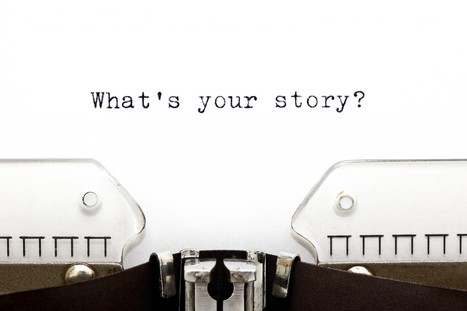


![A Visual Guide to Telling Compelling Stories for Your Brand [Infographic] | Public Relations & Social Marketing Insight | Scoop.it](https://img.scoop.it/bdgdY0H6lziC8cidQvoRtTl72eJkfbmt4t8yenImKBVvK0kTmF0xjctABnaLJIm9)












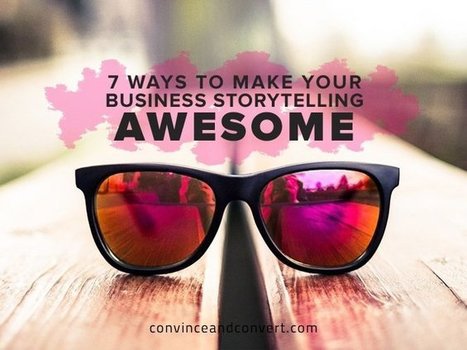





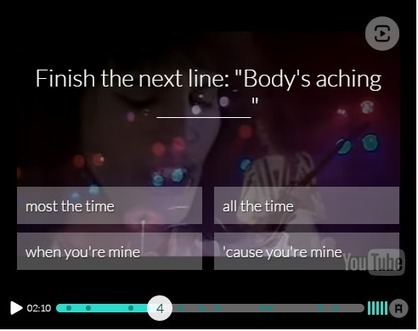



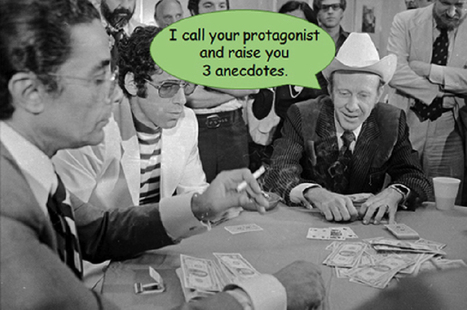
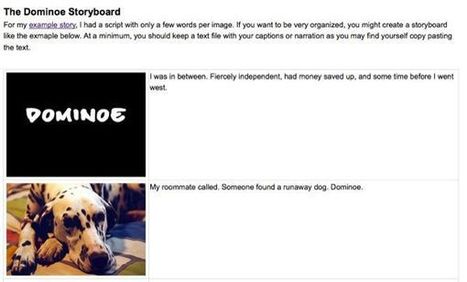
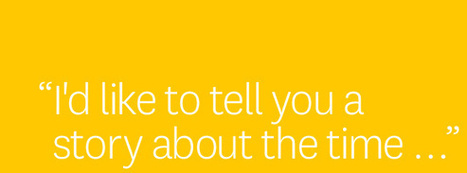






Storyselling can help sell and here are four plots to consider